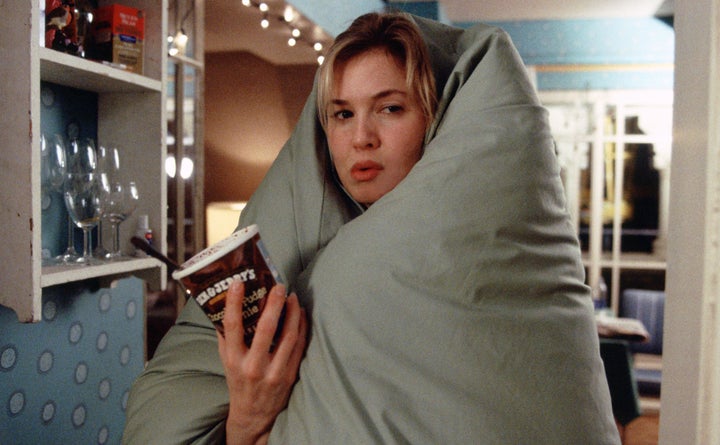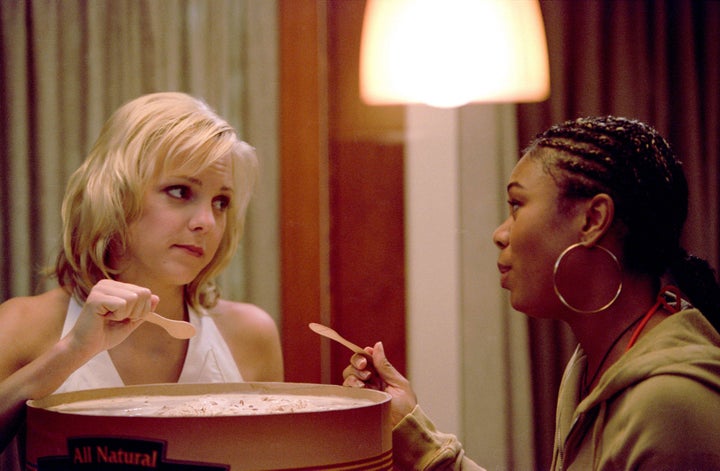
Even if you’re currently in a happy relationship, at some point you’ve probably experienced heartbreak, and many of us have been the stereotypical person grabbing a pint of ice cream out of the freezer to soothe our pain.
In 2004’s ”Edge of Reason” film adaptation, Bridget Jones famously wrapped herself in a comforter and scooped up Ben & Jerry’s ice cream to chase away her love triangle blues. “Scary Movie 3” took the image a step further when Anna Faris and Regina Hall ate from a colossal tub of ice cream. Whether it’s “The Incredibles’” Violet turning invisible and crying over a pint, “SNL” host Emma Stone eating ice cream and crying while listening to Adele, Rory Gilmore “wallowing” or powerhouse Congresswoman Alexandria Ocasio-Cortez posting an Instagram story of enjoying Stephen Colbert’s Ben & Jerry’s Americone Dream after a long day of battling haters, most of the ice cream mollycoddling we see in pop culture focuses on women.
However, Chandler (Matthew Perry) in ”Friends” broke the stereotype in season three (1996) of the series. Monica and Rachel offered him a tub of generic French vanilla, and he complained it “tastes like crap.” Rachel said, “Yeah, well that’s that low-cal, non-dairy, soy milk junk. We save the real stuff for the truly terminal cases.” And Monica added, “You know, when you start getting screwed over all the time, you gotta switch to low-fat.” Today, they’d be eating Halo Top.
Food psychologist Jen Bateman explains that one reason we rely on ice cream is because it stirs up nostalgia. “Specific cravings are often linked to experiences of those foods in our past,” she told HuffPost. “People who were offered ice cream as a distraction when upset, or have positive associations of ice cream in the past, are more likely to crave it in the here and now.”
Besides happy childhood memories, where did this idea of eating ice cream when we’re sad come from, and does fat and sugar actually help us mitigate sadness?
Ashley Gearhardt, a University of Michigan associate professor of psychology and a clinical psychologist, performs research at the university’s FAST (Food Addiction Science and Treatment) Lab. Her focus is on the association between highly processed junk foods and whether they trigger addictive properties similar to cigarettes and booze.
“Our brains are really set up to find highly caloric things rewarding,” Gearhardt told HuffPost. “Ice cream has two of the ingredients that we’re engineered to have a big reward response to: fat and sugar. We’ve gotten so good at mass-producing these hyper-rewarding foods. Now it’s not just chocolate [ice cream that does it for us]. It’s chocolate with chunks of marshmallow and fudge ripple in it.”

Although one study suggests ice cream makes people happy, Gearhardt mentioned a 2012 study that Kyle S. Burger and Eric Stice published in which they discovered people received limited contentment from the treat. They studied people who consumed ice cream-based chocolate milkshakes. While the participants drank the shake, the researchers ran fMRIs on their brain responses. The conclusion: “Our results provide novel evidence that frequent consumption of ice cream, independent of body fat, is related to a reduction in reward-region responsivity in humans, paralleling the tolerance observed in drug addiction.” Yes, drug addiction.
“Individuals who were the most frequent consumers of chocolate ice cream got less reward-related brain responses than those who didn’t eat it more frequently,” Gearhardt explained. (She was not involved in the study.) “The idea thinking, that maybe the more you’re consuming something, your body adapts and becomes tolerant to it. You don’t get as much bang for your buck as you used to, so maybe you need even sweeter ice cream or maybe more ice cream to get what you’re expecting to get.”
Once the “high” from the sugar subsided, Gearhardt said many people felt remorse. “You get this one-two punch of you’re not in a great place, you have these emotional memories, you have expectations. Marketing and advertising tells us, ‘Oh you’re feeling cranky, and a Snickers or ice cream, that’s what’s going to make you feel better.’ We really encode these things, and when you eat it, it doesn’t quite live up to the hype.”
Gearhardt said people not only feel regret but also nauseated and low-energy, and in order to achieve that hyper reward, they’ll turn to other snack foods, like potato chips, or even alcohol
Gearhardt suggested that women-eating-ice cream became ingrained in pop-culture maybe because men approach depression different than women do. “If a guy’s really sad, or something bad has happened to him, we see in culture a lot of them going to the bar and drinking it away,” she said. “But for women — this is changing, though [more women are abusing alcohol] — there were gender norms that alcohol and other drugs of abuse weren’t appropriate for women to use to cope.”
“Some research suggests that women are more likely to use eating to numb, distract and soothe emotions,” Jessica Bihuniak, a dietitian and an assistant professor of clinical nutrition at New York University, told HuffPost.
Sandra Bullock satirized this idea in “Miss Congeniality” (2000) and took “give me a pint” to a new level. As she sat at the bar, feeling down in the dumps and eating a burger, the bartender presented her with the “pint” — a whole container of Ben & Jerry’s chocolate chip cookie dough (more product placement). “I’m gonna get shit-faced,” she joked.
“If you’re not societally allowed to go to the bar and pour a whiskey and drink the pain away, then ice cream is the gendered-appropriate alternative,” Gearhardt said.
The first spoonful always tastes the best, but Gearhardt said the more ice cream you eat, the more it leads to diminishing returns, and it gets to the point where “I don’t even taste it.” (In 2013, researchers at Würzburg University in Germany published a study on how sadness can mask our ability to taste fat.) “It’s not about the pleasure or joy or paying attention to the taste,” she said. “It’s almost like, I’m kind of zoned out and just shoveling it in my mouth.”
Healthy foods like veggies and fruit can boost moods, but Gearhardt said the best way to manage sadness or heartache is to engage in a non-food activity, such as social support, exercising (Olivia Pope from ”Scandal” and later season Don Draper from ”Mad Men” swam laps) and reading a book. “I think throwing food at it, when you’re not hungry, is not going to fix the problem. So whether it’s carrots and apples or ice cream, at the end of the day you’re still probably going to still feel sad. It’s OK to want to take care of yourself as long as it’s not a problem for people.”
Bihuniak echoed the non-food activity. “In general, eating ice cream is completely fine and should be enjoyed, but I do not recommend using it as a coping strategy,” she said. “I don’t believe people should depend on food to feel happy. … In some cases, I have suggested using modeling clay or Play-Doh as a mood enhancer. Using our hands in a creative manner can be very rewarding.”
But to avoid problems like binge-eating and eating disorders, Gearhardt said people need to identify real expectations related to food. “What are the expectations people have about junk food and are they actually what they’re experiencing? Those expectations can keep the behaviors going, and the more society shows Bridget Jones at home with her ice cream, it kind of influences those expectations.”